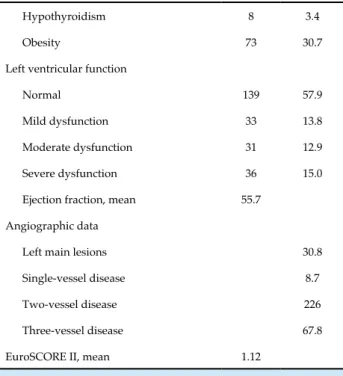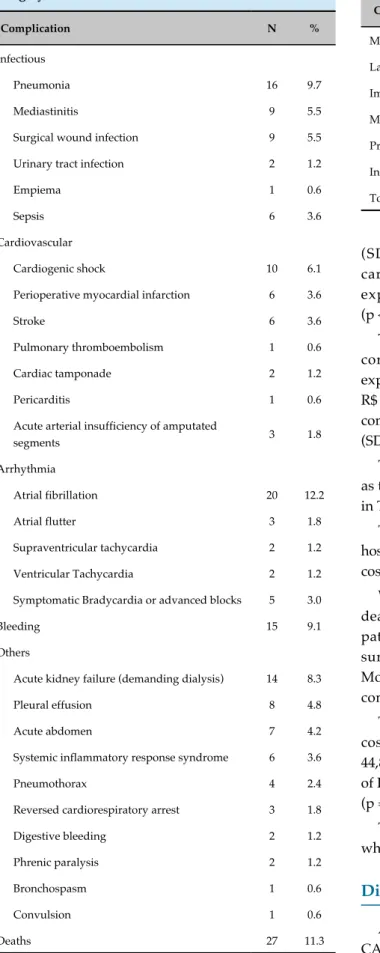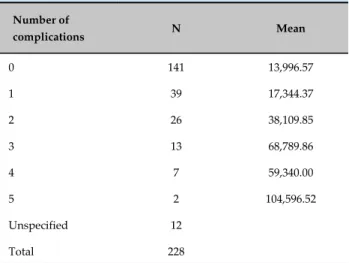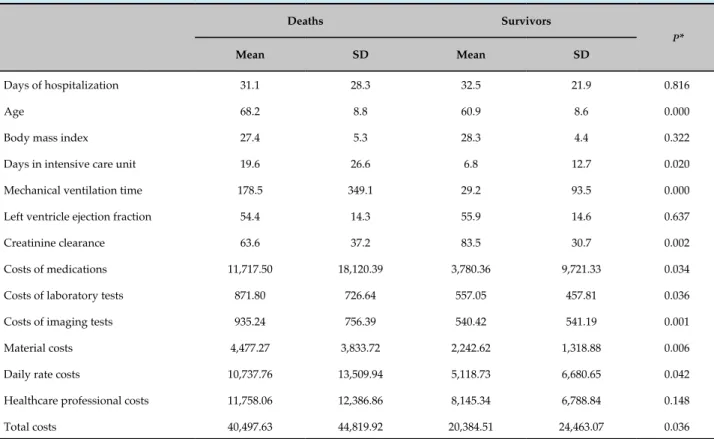DOI: 10.5935/2359-4802.20180083
ORIGINAL ARTICLE
Mailing Address: João Luis Barbosa
Av. Embaixador Abelardo Bueno, 3250/BL 2/603. Postal Code: 22775-040, Barra da Tijuca, Rio de Janeiro - Brazil. E-mail: joaoluis@cardiol.br
Impact of Complications of Myocardial Revascularization Surgery on Expenses During
Hospital Stay
João Luís Barbosa,1,2,4 Clarissa Antunes Thiers,1 Anderson Ferreira Rolim da Silva,2 Marcos Maia Vianna,2 Paulo Otávio de Paula Ravaglia Gedeon,2 Lauro Martins Neto,2 Marina Brunner Uchôa Dantas Moreira,2 Luiz Felipe Faria,2,3 Bernardo Rangel Tura1
Instituto Nacional de Cardiologia (INC),1 Rio de Janeiro, RJ - Brazil
Universidade Estácio de Sá,2 Rio de Janeiro, RJ - Brazil
Universidade Fluminense Federal (UFF),3 Niterói, RJ - Brazil
Universidade Federal do Rio de Janeiro (UFRJ),4 Rio de Janeiro, RJ - Brazil
Manuscript received on August 12, 2017, revised manuscript on May 04, 2018, accepted on June 06, 2018.
Abstract
Background: Coronary artery bypass grafting (CABG) is an important treatment option for obstructive coronary artery disease, but it represents a high expense for paying sources. The complications of CABG impose an additional expense to the procedure that is not yet clearly established.
Objective: To determine the economic impact of postoperative complications of CABG during hospitalization in a hospital of the unified health system (SUS).
Methods: This is an observational study involving 240 patients undergoing isolated CABG in a reference hospital in cardiology in 2013. Patients aged over 30 years with proven coronary artery disease and indication to perform CRVM were included. Patients who performed CRVM associated with other procedures were excluded.
Results: The average cost of hospitalization was R$ 22,647.24 (SD = R$ 28,105.66). In 97 patients who presented some complication the average cost was R$ 35,400.28 (SD = R$ 40,509.47), and in the 143 patients without complications the average cost was R$ 13,996.57 (SD = R$ 5,800.61) (p < 0.001). Expenditures ranged from R$ 17,344.37 in patients with one complication up to R$ 104,596.52 in patients with five complications (p < 0.001).
Conclusions: The occurrence of complications during hospitalization for CABG significantly increases the costs of the procedure, but the magnitude of this increase depends on the type of complication developed, and higher expenses related to cardiovascular complications, infections and bleeding. With this information, managers can improve the allocation of resources to health. (Int J Cardiovasc Sci. 2019;32(1)28-34)
Keywords: Myocardial Revascularization/economy; Myocardial Revascularization/complications; Hospital Costs/trends; Hospitalization; Cardiovascular Diseases/economy.
Introduction
Cardiovascular diseases are the main cause of mortality worldwide1, and ischemic heart disease
accounts for about 7,500,000 deaths per year.1 In
Brazil, ischemic heart disease causes 107,916 deaths per year.2
Hospital stays and diagnostic and therapeutic procedures related with coronary artery disease (CAD)
Methods
This is a single-center observational retrospective study. We selected 240 patients undergoing CABG at the National Institute of Cardiology (INC) in the period from 01 January to 31 December, 2013.
We included patients aged over 30 years, of both genders, with coronary artery disease confirmed by coronary angiography and indication for surgical myocardial revascularization after evaluation by the medical staff, composed of a clinical cardiologist, a hemodynamicist and a cardiac surgeon. We excluded patients who had undergone surgical myocardial revascularization combined with other surgical procedures, such as valve surgeries and vascular surgeries.
Hospitalization costs related to medications, laboratory tests, complementary imaging tests, materials, healthcare professionals and other indirect costs, collected from patients’ medical records, were counted in accordance with the data provided by the cost centers. Indirect costs data were obtained from the Transparency Portal of the Brazilian Federal Government. Service agreements and expenses with security, food, information technology, contracting of general services, engineering companies, and maintenance of medical equipment were counted. The consolidated results allowed for the apportionment of the indirect costs per patient day. The costs with healthcare professionals were calculated according with the number of clinical doctors, surgeons, anesthetists, nurses, nursing technicians, physiotherapists, nutritionists and speech therapists who worked in the care of each patient. Subsequently, data related to the wages and workload of each professional were obtained from the Transparency Portal of the Brazilian Federal Government and, with this information, it was possible to estimate the value per hour worked by each professional involved in the healthcare of each patient, in each hospital sector where this patient remained hospitalized. We used the micro-costing method, in which the interventions performed on the patients are individually counted, finally leading to the total hospitalization costs. The values used as basis of cost estimation were obtained from the Table of Procedures and Medications of SUS Managing System (SIGTAP).
Statistical analysis
The statistical analysis of the continuous quantitative variables was carried out by the Student’s t-test, or the
Mann-Whitney’s U test, to compare both samples, and the ANOVA test or the Kruskal-Wallis test to compare more than two samples. The results of these analyses were expressed as media and standard deviation. The categorical variables were assessed using the qui-square test or the exact Fisher’s test. The results of the analysis of the categorical variables were expressed as percentage. The assessment of normality was performed using the Kolmogorov-Smirnov test, and the equality of the variances was assessed using the Levene’s test. An α value of 0.05 was determined. The analysis was performed using the IBM SPSS (Statistical Package for the Social Science) software (version 20.0.0).
The research project was approved by the Ethics Committee in Research of the National Institute of Cardiology (approval number 648.089; CAAE: 30460013.4.0000.5257). The study was conducted in accordance with the principles of the Declaration of Helsinki.
Results
A total of 240 patients, 169 males and 71 females, who had undergone isolated myocardial revascularization at the National Institute of Cardiology, in 2013, were observed as shown in Table 1.
Mean age was 61.7 years, 60.9 for men and 63.4 for women (p = 0.054). Twenty-four patients were over 75 years of age (10.0%).
The mean time of hospital stay was 32.3 days with standard deviation of 22.7 days. The patients waited, on average, 14.2 days for the surgery, with standard deviation of 8.4. The average recovery period after surgery was 18.4 days, with standard deviation of 20.9 days.
In total, 97 patients incurred complications of some type during hospitalization, corresponding to 40.4% of patients. Complications were grouped into categories related to infectious complications, cardiovascular complications, arrhythmia, bleeding and others, which could not be classified in the other groups, as shown in Table 2.
Direct costs were analyzed by the micro-costing approach and organized into groups relating to medications, laboratory and complementary imaging tests, material and professional costs.
Table 1 - Patients’ data
Demographic profile n %
Age, mean 61.7
Male 169 70.4
Anthropometric data, mean
Weight (kg) 76.2
Height (m) 1.64
Creatinine clearance (mL/min) 81.3 Body mass index 28.2
Cause of hospitalization
Stable CAD without angina 11 4.6 Stable angina 130 54.2
CCS I 8 3.3
CCS II 43 17.9
CCS III 65 27.1
CCS IV 14 5.8
Unstable angina 40 16.7
NSTEMI 32 13.3
STEMI 23 9.6
Others 4 1.7
Clinical history
Systemic arterial hypertension 229 95.4 Diabetes mellitus 110 46.0 Dyslipidemia 183 76.6
Current smoking 67 28.2 Previous smoking 83 34.7 Sedentary lifestyle 51 21.4
Previous MI 127 53.4
Previous PTCA 23 9.7
Arrhythmia 6 2.5
Family history of CAD 39 16.4
Peripheral artery disease 20 8.4 Carotid artery disease 6 2.5 Chronic kidney disease 19 8.0 Chronic obstructive pulmonar disease 11 4.6
Alcoholism 12 5.0
Previous stroke 9 3.8
Hypothyroidism 8 3.4
Obesity 73 30.7
Left ventricular function
Normal 139 57.9
Mild dysfunction 33 13.8
Moderate dysfunction 31 12.9 Severe dysfunction 36 15.0 Ejection fraction, mean 55.7
Angiographic data
Left main lesions 30.8 Single-vessel disease 8.7 Two-vessel disease 226
Three-vessel disease 67.8 EuroSCORE II, mean 1.12
CAD: Coronary Artery Disease; CCS: Canadian Cardiovascular Society (angina pectoris grading system); NSTEMI: non-ST-segment elevation myocardial infarction; STEMI: ST-elevation myocardial infarction.
The mean expenditure of hospitalization was R$ 22,647.24, with a median of R$ 14,772.98 and standard deviation of R$ 28,105.66.
In patients with any complication, corresponding to 97 individuals (40.4%), the mean expenditure was R$ 35,400.28, with standard deviation of R$ 40,509.47, and in those without complications, corresponding to 143 individuals (59.6%), the average expenditure was R$ 13,996.57, with standard deviation of R$ 5,800.61 (p < 0.001).
However, the complications and their associated costs may vary according to each category.
The 17 patients who evolved to bleeding, had a mean hospital expenditure of R$ 37,196.45 (SD = R$ 25,855.71), whereas the 223 patients without bleeding showed an expenditure of R$ 21,538.10 (SD = R$ 28,014.13) (p < 0.021).
The 27 patients with arrhythmia had an average expenditure of R$ 31,760.52 (SD = R$ 22.416,23), whereas the 213 patients without arrhythmia showed an average expenditure of R$ 21,492.03 (SD = R$ 28,583.01) (p < 0.074).
Table 2 - Complications in patients undergoing CABG surgery
Complication N %
Infectious
Pneumonia 16 9.7
Mediastinitis 9 5.5
Surgical wound infection 9 5.5 Urinary tract infection 2 1.2
Empiema 1 0.6
Sepsis 6 3.6
Cardiovascular
Cardiogenic shock 10 6.1 Perioperative myocardial infarction 6 3.6
Stroke 6 3.6
Pulmonary thromboembolism 1 0.6 Cardiac tamponade 2 1.2
Pericarditis 1 0.6
Acute arterial insufficiency of amputated
segments 3 1.8
Arrhythmia
Atrial fibrillation 20 12.2
Atrial flutter 3 1.8
Supraventricular tachycardia 2 1.2 Ventricular Tachycardia 2 1.2 Symptomatic Bradycardia or advanced blocks 5 3.0
Bleeding 15 9.1
Others
Acute kidney failure (demanding dialysis) 14 8.3 Pleural effusion 8 4.8
Acute abdomen 7 4.2
Systemic inflammatory response syndrome 6 3.6
Pneumothorax 4 2.4
Reversed cardiorespiratory arrest 3 1.8 Digestive bleeding 2 1.2
Phrenic paralysis 2 1.2
Bronchospasm 1 0.6
Convulsion 1 0.6
Deaths 27 11.3
Table 3 - Average costs during hospitalization
Cost R$ %
Medications 4,673.29 20.6 Laboratory tests 592.46 2.6 Imaging tests 584.83 2.6
Materials 2,494.02 11.0 Profissionals 8,551.77 37.8 Indirect costs 5,750.87 25.4 Total 22,647.24 100.0
(SD = R$ 56,287.27), and the patients without cardiovascular complications showed an average expenditure of R$ 18,409.06 (SD = R$ 15,902.53) (p < 0.005).
The patients with infectious complications, corresponding to 37 individuals, showed a mean expenditure of hospitalization of R$ 53,949.79 (SD = R$ 56,814.94), whereas the patients without infectious complications showed an expenditure of R$ 16,941.84 (SD = R$ 12,130.63) (p < 0.001).
The additional expenditures for complications, as well as the additional mean length of stay are demonstrated in Table 4.
The occurrence of multiple complications during hospital stay are associated with increased hospitalization costs, as shown in Table 5.
With regard to the intra-hospital mortality, 27 deaths (11.3%) were observed. The mean age of the patients who died was 68.2 years, whereas those who survived had a mean age of 60.9 years (p = 0.001). Mortality in patients who presented with at least one complication was 27.8%.
The patients who died had an average hospitalization cost of R$ 40,497.63, with standard deviation of R$ 44,819.92, whereas those who survived had a mean cost of R$ 20,384.51, with standard deviation of R$ 24,463.07 (p = 0.036).
Table 6 shows the comparisons between the patients who died and those who survived.
Discussion
Table 4 - Additional expenditures for complications
Complications
Average costs (± standard
deviation)
Additional costs due to complications
Mean length of hospitalization (± standard deviation)
Additional time of hospitalization due to complications
All patients 22,647.24 (±28,105.66) - 32.3 (±22.7) -Patients without complications 13,996.57 (±5,800.61) - 25.3 (±11.6) -Patients with any complication 35,400.28 (±40,509.47) 21,403.71 42.8 (±29.9) 17.5 Patients with any specific complication compared to all the other patients
Infectious complications 53,949.79 (±56,814.94) 37,007.95 58.0 (±38.6) 30.3 Cardiovascular complications 45,899.94 (±56,287.27) 27,490.88 50.1 (±39.2) 21.0 Arrhythmia 31,760.52 (±22,416.23) 10,268.49 39.8 (±15.9) 8.4 Bleeding 37,196.45 (±25,855.71) 15,658.35 43.6 (±18.1) 12.1
Table 5 - Mean expenditures according with the number of complications
Number of
complications N Mean
0 141 13,996.57
1 39 17,344.37
2 26 38,109.85
3 13 68,789.86
4 7 59,340.00
5 2 104,596.52
Unspecified 12
Total 228
p < 0.001 (Kruskal-Wallis test).
is a procedure of high complexity and cost, and it is performed in a large number of patients during the treatment of ischemic cardiac disease, allowing for a rational and evidence-based use of healthcare resources.
In this study, the average cost of hospitalization was higher than that found in other studies carried out in Brazil. A prospective study performed with 103 coronary patients submitted to isolated elective CABG, observed that the average cost of hospitalization was R$ 6,990.30.3
The occurrence of complications is associated with increased hospitalization costs, but this increase depends on the type of complication observed. The most frequent
were infectious and cardiovascular complications, followed by arrhythmia and bleeding.
The patients who presented cardiovascular complications, infectious complications and bleeding in the CABG postoperative period had a higher average hospitalization cost than the patients without these complications, because they consumed more material and human resources. In addition, they demanded a longer length of hospital stay.
Twenty-seven patients were diagnosed with arrhythmia-related complications during the postoperative period. The occurrence of atrial fibrillation (AF) was 12.2%, corresponding to 20 patients, a lower percentage compared to the percentage observed in another study, in which 33.6% of the patients presented atrial fibrillation.4 This
result is in accordance with a study that observed that atrial fibrillation occurred in 15.2% of the patients analysed5
and another study that observed that atrial fibrillation occurred in 17.2% of patients, being the most frequent complication.6 Another study demonstrated that patients
who evolved with atrial fibrillation during the CABG postoperative period had a higher average hospitalization cost compared to the patients without arrhythmia,7 which
cannot be confirmed by this study.
Patients who evolved with infectious complications had a higher cost compared to the patients who evolved without nosocomial infections. HILLIS LD et al.,8
Table 6 - Comparison of costs between patients who died and patients who survived
Deaths Survivors
P*
Mean SD Mean SD
Days of hospitalization 31.1 28.3 32.5 21.9 0.816
Age 68.2 8.8 60.9 8.6 0.000
Body mass index 27.4 5.3 28.3 4.4 0.322
Days in intensive care unit 19.6 26.6 6.8 12.7 0.020
Mechanical ventilation time 178.5 349.1 29.2 93.5 0.000 Left ventricle ejection fraction 54.4 14.3 55.9 14.6 0.637
Creatinine clearance 63.6 37.2 83.5 30.7 0.002
Costs of medications 11,717.50 18,120.39 3,780.36 9,721.33 0.034
Costs of laboratory tests 871.80 726.64 557.05 457.81 0.036 Costs of imaging tests 935.24 756.39 540.42 541.19 0.001 Material costs 4,477.27 3,833.72 2,242.62 1,318.88 0.006 Daily rate costs 10,737.76 13,509.94 5,118.73 6,680.65 0.042
Healthcare professional costs 11,758.06 12,386.86 8,145.34 6,788.84 0.148 Total costs 40,497.63 44,819.92 20,384.51 24,463.07 0.036
* Statistical Analysis performed with the Student's t test.
surgery and deep sternal wound infection in 0.45% to 5% of cases. A study conducted in the state of Rio Grande do Sul with 717 patients observed an incidence of infections in the postoperative period of CABG of 19.1%, a higher percentage compared to the percentage found in this study (15.4%).9 Surgical wound infections after
CABG extend the length of hospital stay and increase hospitalization costs. The increase in hospitalization costs was attributed to more frequent use of antimicrobial agents in patients who had nosocomial infection.10
Patients with cardiovascular complications also had increased hospitalization cost. A study carried out identified that cardiovascular complications, such as stroke and postoperative shock following CABG increased hospitalization costs, because greater material and human resources were necessary due to extended length of hospital stay.11
Patients who had bleeding during the CABG postoperative period had a higher average hospitalization cost compared to patients without bleeding. Other studies also report the impact of this complication on the increase of hospital costs.11,12
The mortality rate observed in this study is similar to the one found in other Brazilian studies,13 which
showed a mortality rate of 13%. Another study carried out in Brazil,14 in the city of Rio de Janeiro, showed that
in-hospital CABG mortality in four hospitals ranged from 7.0% to 14.3%, with a joint mortality rate of 10.9%.
The patients who died had a higher cost compared to the survivors. This result is in accordance with another study5 performed with 14,780 patients submitted to
isolated CABG, which demonstrated that the patients who died had higher hospital costs, with an average cost of US$ 49,242, currently corresponding to R$ 178,748.46.
1. World Health Organization (WHO). World health statistics 2016: monitoring health for the SDGs, sustainable development goals. Geneva;2016.
2. BRASIL. Ministério da Saúde. Secretaria Executiva. Datasus. Informações de saúde. [Citado em 2016 nov 01]. Disponível em: <http://www2. datasus.gov.br/DATASUS/index.php?area=02>
3. Haddad N, Bittar E, Marchi AF, Kantorowitz CS, Ayoub AC, Fonseca ML, et al. Custos hospitalares da cirurgia de revascularização do miocárdio em pacientes coronarianos eletivos. Arq Bras Cardiol. 2007;88(4):418-23.
4. Girardi PB, Hueb WA, Nogueira CR, Takiuti ME, Nakano T, Garzillo CL, et al. Comparative costs between myocardial revascularization with or without extracorporeal circulation. Arq Bras Cardiol. 2008;91(6):369-76.
5. Speir AM, Kasirajan V, Barnett SD, Fonner E Jr. Additive costs of postoperative complications for isolated coronary artery bypass grafting patients in virginia. Ann Thorac Surg. 2009;88(1):40-6.
6. Osnabrugge RL, Speir AM, Head SJ, Jones PG, Ailawadi G, Fonner CE, et al. Prediction of costs and length of stay in coronary artery bypass grafting. Ann Thorac Surg. 2014;98(4):1286–93.
7. Almassi GH, Wagner TH, Carr B, Hattler B, Collins JF, Quin JA, et al. Postoperative atrial fibrillation impacts on costs and one-year clinical outcomes: the veterans affairs randomized on/off bypass trial. Ann Thorac Surg. 2015;99(1):109-14.
8. Hillis LD, Smith PK, Anderson JL, Bittl JA, Bridges CR, Byrne JG, et al. ACCF/AHA Guideline for Coronary Artery Bypass Graft Surgery: a
report of the American College of Cardiology Foundation/American Heart Association Task Force on Practice Guidelines. Circulation. 2011;124(23):e652–735.
9. Ledur P, Almeida L, Pellanda LC, Schaan BD. Predictors of infection in post-coronary artery bypass graft surgery. Braz J Cardiovasc Surg. 2011;26(2):190-6.
10. Kobayashi J, Kusachi S, Sawa Y, Motomura N, Imoto Y, Makuuchi H, et al. Socioeconomic effects of surgical site infection after cardiac surgery in Japan. Surg Today. 2015;45(4):422-8.
11. Brown PP, Kugelmass AD, Cohen DJ, Reynolds MR, Culler SD, Dee AD, et al. The frequency and cost of complications associated with coronary artery bypass grafting surgery: results from the United States Medicare program. Ann Thorac Surg. 2008;85(6):1980–6.
12. Kilic A. Shah AS, Conte JV, Mandal K, Baumgartner WA, Cameron DE, et al. Understanding variability in hospital-specific costs of coronary artery bypass grafting represents an opportunity for standardizing care and improving resource use. J Thorac Cardiovasc Surg. 2014;147(1):109-15.
13. Sá MP, Soares EF, Santos CA, Figueredo OJ, Lima RO, Escobar RR, et al. EuroSCORE and mortality in coronary artery bypass graft surgery at Pernambuco Cardiologic Emergency Medical Services. Rev Bras Cir Cardiovasc. 2010;25(4):474-82.
14. Oliveira TM, Oliveira GM, Klein CH, Souza E Silva NA, Godoy PH.. Mortality and complications of coronary artery bypass grafting in Rio de Janeiro, from 1999 to 2003. Arq Bras Cardiol. 2010;95(3):303-12.
References
This is an open-access article distributed under the terms of the Creative Commons Attribution License
Another limitation of this study is related with the non-inclusion of patients who were readmitted precociously due to late surgical complications, since the discharge from hospital can happen before the occurrence of any clinical manifestation.
Conclusions
We conclude that the occurrence of complications during CABG hospitalization significantly increases the expenditures with the procedure, but the magnitude of this increase will depend on the type of complication developed, with the highest costs being related to cardiovascular complications, infectious complications and bleeding.
Author contributions
Conception and design of the research: Barbosa JL. Acquisition of data: Barbosa JL, Silva AFR, Vianna MM, Gedeon POPR, Martins Neto L, Moreira MBUD, Faria LF. Analysis and interpretation of the data: Barbosa JL, Thiers CA, Tura BR. Statistical analysis: Barbosa JL. Writing of the manuscript: Barbosa JL. Critical revision
of the manuscript for intellectual content: Barbosa JL, Thiers CA, Tura BR.
Potential Conflict of Interest
No potential conflict of interest relevant to this article was reported.
Sources of Funding
There were no external funding sources for this study.
Study Association
This article is part of the thesis of Doctoral submitted by João Luís Barbosa, from Universidade Federal do Rio de Janeiro (UFRJ).
Ethics approval and consent to participate



